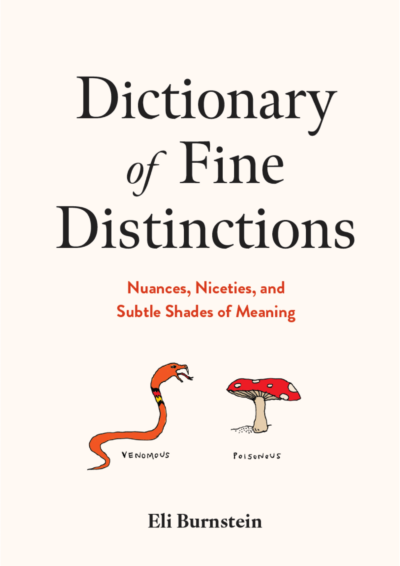Dictionary of Fine Distinctions: Nuances, Niceties, and Subtle Shades of Meaning
Eli Burnstein
(Union Square & Co, $26, 201 pages)
 Dictionary of Fine Distinctions is a charming little book that uses pithy descriptions and cute illustrations to delineate the meaning of words that are often confused for one another. Most of these clarifying notes are done so in easily to digest one or two pages, some benefiting from longer (one paragraph) descriptions of the differences. For example, Burnstein has an illustration of a man who looks like Jesus talking to two followers and a definition of parable as “a brief tale with a moral lesson.” Underneath, there is a line illustration of a tortoise crossing a finish line just ahead of a hare and the definition of fable as “a brief tale with a moral lesson – plus animals.” In an additional paragraph on the opposite page, Burnstein notes that fables “personify animals to illustrate a point of human folly” and “tend to be lighter, more ironic fare,” than parables that “try to convey a deeper and more complex message about the human condition.”
Dictionary of Fine Distinctions is a charming little book that uses pithy descriptions and cute illustrations to delineate the meaning of words that are often confused for one another. Most of these clarifying notes are done so in easily to digest one or two pages, some benefiting from longer (one paragraph) descriptions of the differences. For example, Burnstein has an illustration of a man who looks like Jesus talking to two followers and a definition of parable as “a brief tale with a moral lesson.” Underneath, there is a line illustration of a tortoise crossing a finish line just ahead of a hare and the definition of fable as “a brief tale with a moral lesson – plus animals.” In an additional paragraph on the opposite page, Burnstein notes that fables “personify animals to illustrate a point of human folly” and “tend to be lighter, more ironic fare,” than parables that “try to convey a deeper and more complex message about the human condition.”
Burnstein covers a wide array of subject matter, from geographical terms (a gully, ravine, gorge, and canyon), household terms (porch, deck, veranda, and patio), music (4/4 time vs. 2/2 time), mathematics (natural numbers, integers, rational numbers, and real numbers), and seeming synonyms (convince v. persuade, sound v. valid, assume v. presume). For one set of commonly confused words Burnstein observes that “epigrams are witty,” “aphorisms are philosophical,” “maxims are rules of conduct,” “adages are old and well-known,” and “proverbs are folk/traditional) and that the latter three tend not to be attributable to an author. Burnstein adds that “old adage” is “considered by many usage experts to be redundant.” From this tiny volume the editor found that he has been making an error for more than 20 years, asking the production designer to change the font when he meant typeface.




